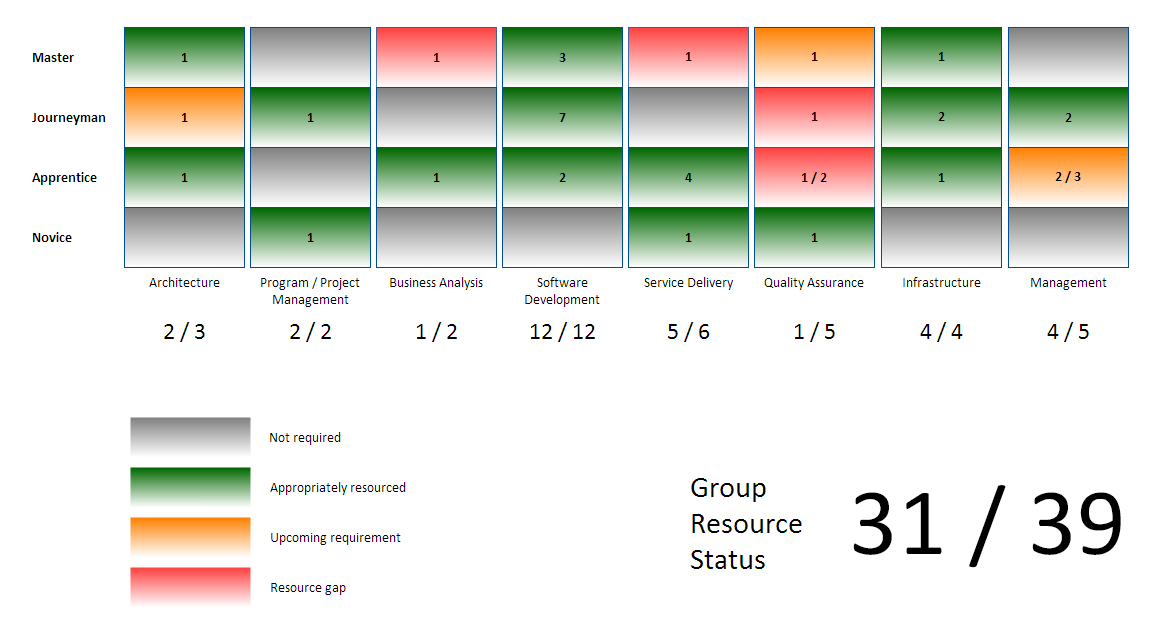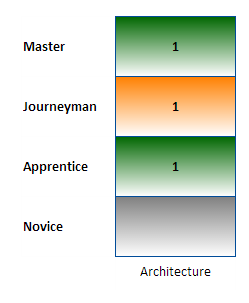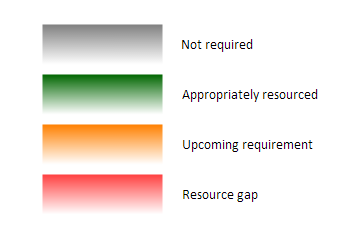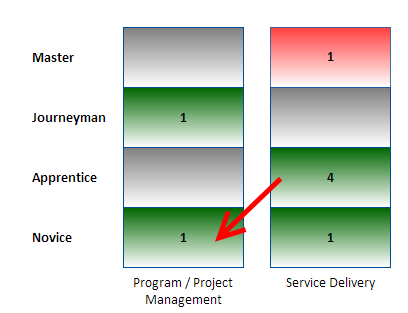The great thing about a good model is that it is extensible. The Craftsperson model, which can be used for personal or team management, can also be extended and applied to manage a cross-functional, multi-disciplinary group.
The framework can be used in a number of ways, but we’ll discuss a couple here:
- A simple overview of the group structure
- A basis for career transition conversations
Craftspeople Management Framework
As always, it’s best to discuss this with an illustration. Here’s an example of the framework depicting a technology group with multiple teams – although note that it can be used to represent any function within an organisation:
While this might look a little complicated and busy, remember that this fictitious group consists of eight teams and 31 people – a necessarily complex environment.
Let’s talk about some of the elements of the framework in a little more detail, and then pull it all together.
Overall group status
The overall Group Resource Status counter indicates how well the group is staffed. The thresholds at which you may start to get alarmed are unique to you and your organisation, but it provides an easy, at-a-glance understanding of whether a recruitment drive should be considered.
Practices
Each column represents a discrete Practice within the group. Practices can be structured in whatever way makes sense to an organisation, but represents a stand-alone area of focus and a fairly standard career path for most people.
This was discussed in some detail in previous posts. Note that Practices don’t necessarily have to mean teams. Teams can consist of individuals from multiple Practices.
Practice Status
Indicates how well an individual Practice is resourced:
Obviously QA needs some attention.
Colour key
The colour key indicates the status of each stage within a Practice.
Gray – The stage is not required, based on the organisation or group’s current operating environment. For example, in the image above the Master stage in Program / Project Management is at “Not Required”. This could be because there are no major programs running, the program or project management is out-sourced, or perhaps even handled by other functions within the company. Similarly, the Novice stage in Software Development is set to “Not Required”, which could be because of policy to only hire slightly experienced software developers rather than fresh graduates who require lots of management attention.
Green – All is well. Nothing to see here folks. Go back to your desks and carry on.
Orange – There is no great urgency, but a need for one or more resources operating at this level has been identified. This should result in conversations about promoting within the ranks if the skills exist, or starting to engage the appropriate recruitment functions.
Red – Houston, we have a problem. A resource gap exists that is impacting current delivery of initiatives, and needs to be addressed urgently.
Resource count
The number in the box for each stage. A single number indicates the resource count (or requirement, in the case of orange or red status):
Alternatively, a fraction in a box indicates an existing or upcoming resource gap. Obviously this can only be an orange or red box:
Bringing it all together – The Framework in action
Okay, so let’s pull it all together and discuss a couple of uses of the framework.
Group Overview
Here is the visualisation of the fictitious group again, and the overview we can glean from it:
- This is a reasonably sized group of 31 technologists.
- The group is structured into 7 distinct Practices, along with management.
- The software development function has a large representation, indicating the overall focus of activities within this group.
- There is a gap of 8 resources to get this group to its target operating effectiveness. 4 of these are required urgently.
- The Quality Assurance Practice is significantly under-resourced.
The visualisation of the framework very quickly lets us understand the group structure and focus, as well as its resourcing health.
Career Transition Conversation
Another useful thing about this framework is that it enables conversations about what career paths may be possible. In our example, let’s pick someone from the Service Delivery Practice – say, an Application Support Analyst – who is at the Apprentice level. They realise that they are starting to mature past their current stage, but there are no current positions available at the next level. They also really want to transition into Project Management:
The framework allows a meaningful conversation to take place. If they have demonstrated the appropriate attitude and aptitude, they would be first in line for the Novice Project Manager role when it is vacated, or more likely, a role would be created for them.
Management as a Practice
One final point: note that I have included Management as a Practice. Just like the rest of the (IT) crafts, management requires following a learning path and growing through the stages. It needs clearly defined levels, with behaviours and measurable metrics to determine progress. Getting promoted into management doesn’t mean you’ve made it. It means you’re a novice just getting started.









